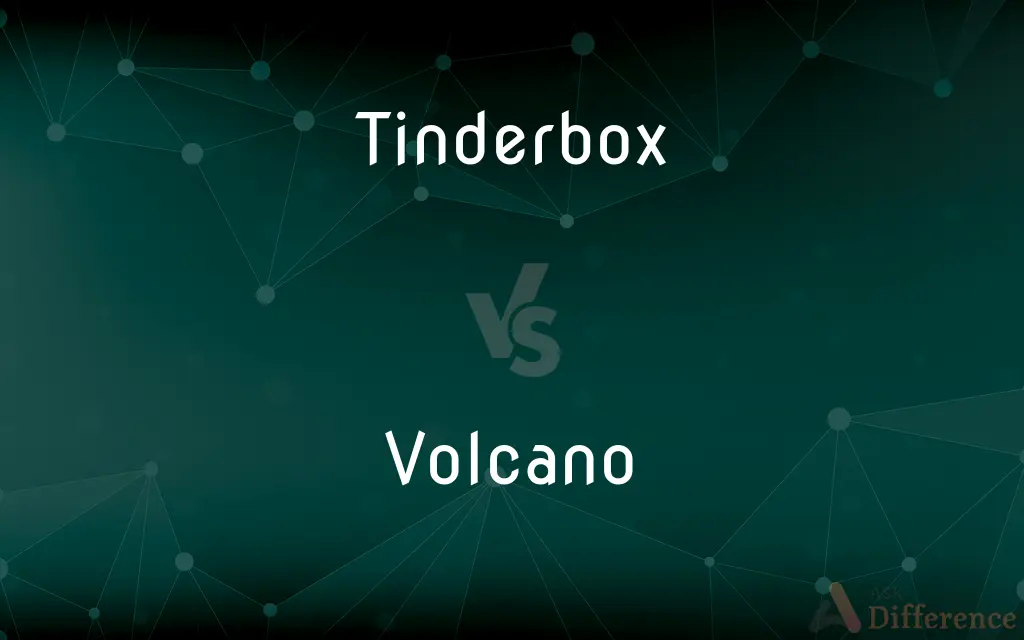Tinderbox vs. Volcano — What's the Difference?
By Fiza Rafique & Maham Liaqat — Updated on April 17, 2024
Tinderbox refers to a highly flammable material or situation prone to rapid ignition, whereas a volcano is a geological formation capable of erupting molten rock.

Difference Between Tinderbox and Volcano
Table of Contents
ADVERTISEMENT
Key Differences
A tinderbox is often used metaphorically to describe situations or environments that can quickly become dangerous or violent, due to accumulated tension or conflict. On the other hand, a volcano refers specifically to a natural geological structure that erupts magma, ash, and gases from beneath the Earth's crust.
Tinderboxes, in their literal sense, consist of dry, combustible material that easily catches fire, often used historically for starting fires with sparks. Whereas, volcanoes are composed of a vent, a magma chamber, and other geological layers, inherently linked to the dynamic processes of the earth’s interior.
While tinderboxes symbolize quick and easy ignition, leading to immediate flames, volcanoes represent a buildup of underground pressures that can result in explosive eruptions or slow lava flows, depending on their type.
The term "tinderbox" can be applied to various scenarios, including dry forests, packed crowds, or volatile markets, emphasizing the risk of rapid escalation. Conversely, volcanoes are specifically located in areas known as volcanic arcs or hotspots, and their activity is studied within the field of volcanology.
Tinderboxes are used in discussions about risks and preventive measures in safety protocols to avoid disaster. Volcanoes, on the other hand, are monitored for their potential to cause widespread natural disasters, impacting climate, landscapes, and human populations over potentially large areas.
ADVERTISEMENT
Comparison Chart
Definition
Material or situation prone to fire
Geological formation that erupts
Composition
Dry, flammable materials
Magma, vent, crater
Usage
Metaphorical and literal
Primarily geological
Symbolism
Sudden danger or conflict
Long-term geological activity
Impact
Immediate, localized
Potentially widespread and enduring
Compare with Definitions
Tinderbox
Highly flammable material.
The dry leaves and branches created a tinderbox in the forest.
Volcano
Natural vent for molten rock.
The volcano's vent was closely monitored for signs of activity.
Tinderbox
Sensitive or volatile setting.
With high unemployment, the city was a tinderbox of social unrest.
Volcano
Opening in Earth’s surface emitting magma.
The volcano spewed lava during the eruption.
Tinderbox
Situation prone to quick escalation.
The political tension in the area was a tinderbox waiting to ignite.
Volcano
Mountain that erupts lava.
Mount Fuji is a dormant volcano that last erupted in 1707.
Tinderbox
Easily ignited environment.
The overcrowded concert hall was a tinderbox during the heatwave.
Volcano
Geological structure with a magma chamber.
Scientists studied the volcano to predict its next eruption.
Tinderbox
Metaphorical use for explosive situations.
The heated debate turned the meeting into a tinderbox.
Volcano
Source of geological activity.
The island was formed by an ancient volcano.
Tinderbox
A tinderbox, or patch box, is a container made of wood or metal containing flint, firesteel, and tinder (typically charcloth, but possibly a small quantity of dry, finely divided fibrous matter such as hemp), used together to help kindle a fire. A tinderbox might also contain sulfur-tipped matches.
Volcano
A volcano is a rupture in the crust of a planetary-mass object, such as Earth, that allows hot lava, volcanic ash, and gases to escape from a magma chamber below the surface. On Earth, volcanoes are most often found where tectonic plates are diverging or converging, and most are found underwater.
Tinderbox
A metal box for holding tinder.
Volcano
An opening in the earth's crust from which lava, ash, and hot gases flow or are ejected during an eruption.
Tinderbox
A potentially explosive place or situation
Referred to the crowded prison as a tinderbox of suppressed violence.
Volcano
A similar opening on the surface of another celestial object.
Tinderbox
(historical) A small container containing flint, steel, and tinder (dry, finely-divided fibrous matter), once used to help kindle a fire.
Volcano
A usually cone-shaped mountain formed from the materials issuing from such an opening.
Tinderbox
(by extension) A place that is so dry and hot that there is danger of fire.
Volcano
A vent or fissure on the surface of a planet (usually in a mountainous form) with a magma chamber attached to the mantle of a planet or moon, periodically erupting forth lava and volcanic gases onto the surface.
Iceland's volcanoes are among the most active on Earth.
Tinderbox
(figurative) A potentially dangerous situation.
Volcano
A kind of firework producing an upward plume of sparks.
Tinderbox
A dangerous state of affairs; a situation that is a potential source of violence;
The Balkans are the tinderbox of Europe
Volcano
To erupt; to burst forth
Tinderbox
A box for holding tinder
Volcano
A mountain or hill, usually more or less conical in form, from which lava, cinders, steam, sulphur gases, and the like, are ejected; - often popularly called a burning mountain.
Volcano
A fissure in the earth's crust (or in the surface of some other planet) through which molten lava and gases erupt
Volcano
A mountain formed by volcanic material
Common Curiosities
Is the term "tinderbox" used in any specific industries or contexts?
Yes, it's often used in emergency management, forestry, and financial markets to describe high-risk conditions.
How do the immediate effects of a tinderbox and a volcano differ?
The immediate effects of a tinderbox are usually fire and potential destruction in a localized area, while a volcano can affect larger regions through ash clouds, lava flow, and atmospheric changes.
What types of volcanoes are there?
There are several types, including stratovolcanoes, shield volcanoes, cinder cone volcanoes, and composite volcanoes.
What are common materials found in a tinderbox?
Common materials include dry leaves, paper, small twigs, or any easily combustible items.
Are there any beneficial aspects to volcanoes?
Yes, volcanoes contribute to the Earth's geology by creating fertile lands, mineral deposits, and geothermal energy resources.
What causes a volcano to erupt?
Eruptions are caused by the pressure of gas and magma building up beneath the Earth's surface.
What long-term effects can a volcano have on the environment?
Volcanic eruptions can alter landscapes, create new landforms, affect global temperatures, and disrupt ecosystems.
What role do human activities play in creating a tinderbox situation?
Human activities such as land clearing, improper disposal of flammable waste, and failure to manage heat sources can create tinderbox conditions.
What types of research are conducted on volcanoes?
Research includes studying magma composition, monitoring seismic activity, and using satellite imagery to predict eruptions.
Can the activity of either a tinderbox or a volcano be predicted?
While tinderboxes can often be prevented through careful management of flammable materials, volcanic activity can sometimes be predicted through seismic and geological monitoring.
How are communities educated about the risks of living near volcanoes?
Communities are educated through public awareness campaigns, school education programs, and regular updates from volcanic observatories.
What safety measures are recommended when living near a volcano?
Recommendations include having an evacuation plan, staying informed about volcanic activity, and adhering to advice from geological agencies.
What are the immediate actions to take if a tinderbox ignites?
Immediate actions include evacuating the area, calling emergency services, and using fire extinguishers or water if safely possible.
Can the effects of a volcanic eruption be mitigated?
Effects can be partially mitigated by early warning systems, effective evacuation routes, and public readiness plans.
How do both tinderboxes and volcanoes relate to climate change?
Tinderboxes, particularly in forested areas, can exacerbate wildfire incidents under climate change, while volcanoes can influence climate by releasing large amounts of volcanic ash and gases that may cool the earth.
Share Your Discovery

Previous Comparison
Hoorah vs. Hurrah
Next Comparison
Proponent vs. PresenterAuthor Spotlight
Written by
Fiza RafiqueFiza Rafique is a skilled content writer at AskDifference.com, where she meticulously refines and enhances written pieces. Drawing from her vast editorial expertise, Fiza ensures clarity, accuracy, and precision in every article. Passionate about language, she continually seeks to elevate the quality of content for readers worldwide.
Co-written by
Maham Liaqat















































